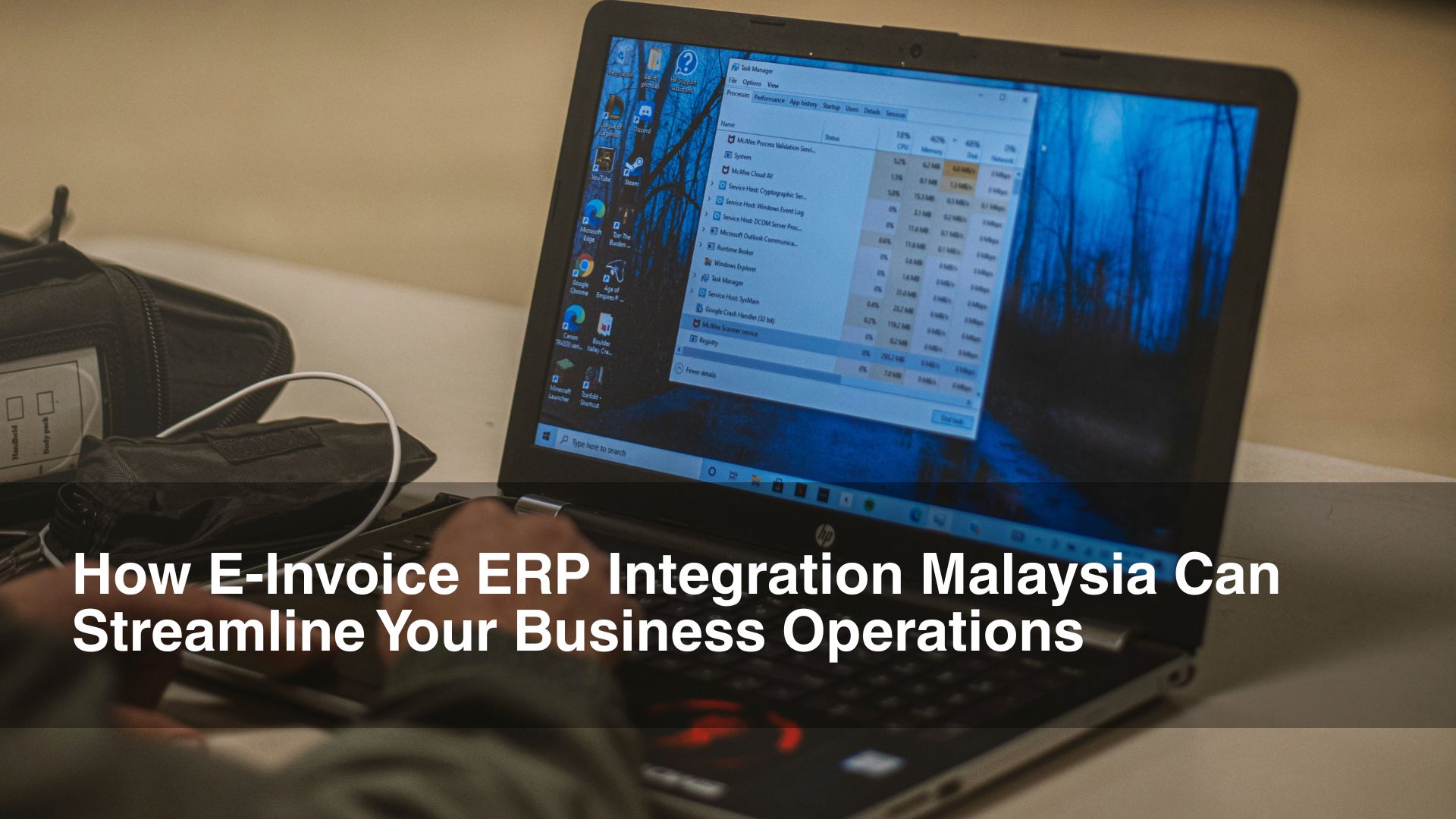Understanding E-Invoice ERP Integration Malaysia
E-invoicing, or electronic invoicing, represents a modern approach to billing where invoices are created, transmitted, received, and processed in a digital format. In the context of e-invoice ERP integration Malaysia, it serves as a critical component within the broader framework of Enterprise Resource Planning (ERP) systems. ERP systems typically encompass various business functions such as finance, inventory management, and human resources, providing a centralized platform for operations. The integration of e-invoicing into these systems enhances the efficiency of financial processes.
The push for e-invoice integration in Malaysia arises from the need for businesses to streamline their operations amidst increasing competition and regulatory pressures. Many companies are recognizing that digital invoicing can significantly reduce the time and cost associated with manual invoicing processes. By digitizing invoices, organizations can ensure faster processing times, minimize errors, and enhance the accuracy of their financial records. Moreover, integrated e-invoicing systems can facilitate seamless communication with clients and suppliers, creating a more efficient supply chain.
However, the journey to integrating e-invoicing within existing ERP frameworks is not without its challenges. Companies may face issues such as resistance to change from employees, complexities in aligning e-invoicing practices with current financial processes, and ensuring compliance with local regulations. Furthermore, the initial investment required for implementing such integration can be significant, which may deter some businesses from proceeding.
Despite these challenges, embracing e-invoice ERP integration Malaysia offers businesses substantial benefits, including improved cash flow management, enhanced visibility into financial operations, and the capacity to adapt to evolving digital standards. The increasing demand for electronic transaction transparency further underscores the importance of this technological shift in Malaysia’s business landscape.
Automating Invoice Workflows with E-Invoice ERP Integration Malaysia
The implementation of e-invoice ERP integration in Malaysia represents a significant advancement in the automation of invoice workflows within businesses. This innovative technology streamlines the entire invoicing process, transforming how companies manage and process invoices from generation through to approval and payment. By harnessing e-invoicing solutions, businesses can eliminate many time-consuming manual procedures that typically hinder efficiency.
One of the critical features of e-invoice ERP integration is the capability for electronic submission of invoices. This functionality allows invoices to be generated and sent electronically without the necessity of paper documentation, which not only accelerates the process but also minimizes the risks of losing vital documents. The adoption of electronic invoicing ensures that all related information is consolidated within a digital framework, enabling easy access and retrieval. Moreover, e-invoice ERP integration facilitates built-in approval workflows, meaning that invoices can be reviewed and approved quickly by authorized personnel regardless of their location, enhancing operational flexibility.
The automation of invoice workflows significantly reduces manual errors that often arise from data entry or approval delays. When invoices are validated electronically, the potential for errors diminishes, leading to more accurate financial records. Additionally, this integration improves processing times by eliminating traditional bottlenecks typically associated with paper-based workflows. Businesses can witness a remarkable enhancement in overall productivity as tasks surrounding invoicing become streamlined and efficient.
Furthermore, e-invoice ERP integration in Malaysia not only simplifies the entire invoicing lifecycle but also provides valuable insights through analytics. Organizations can track invoice statuses in real time, allowing for informed decision-making and better cash flow management. Ultimately, the automation capabilities of e-invoice ERP integration pave the way for a smoother and more effective invoicing process, leading to substantial benefits for businesses looking to enhance their operational efficiency.
Ensuring Compliance: E-Invoice ERP Integration Malaysia and LHDN Regulations
In the context of Malaysian business operations, compliance with the regulations set forth by the Lembaga Hasil Dalam Negeri (LHDN) is of paramount importance. As businesses strive to meet their tax obligations, the integration of e-invoice systems within an ERP framework represents a significant advancement in facilitating adherence to these regulations. E-invoice ERP integration Malaysia allows businesses to generate invoices that are compliant with the intricate stipulations laid out by the LHDN, thereby enhancing the accuracy and validity of financial documentation.
By incorporating e-invoice ERP integration, companies can streamline their invoicing processes, reducing manual entry errors that could lead to compliance issues. Automated systems ensure that invoices are formatted correctly according to the LHDN requirements, which include displaying essential information such as the seller’s and buyer’s details, as well as the appropriate tax calculations. This proactive approach not only minimizes the risk of penalties but also enhances the efficiency of tax reporting procedures.
Moreover, the integration of e-invoices assists businesses in staying updated with the latest changes in tax legislation. LHDN regulations are known to evolve, and having an ERP system that automatically adapts to these updates ensures that invoices remain compliant without requiring constant manual adjustments. Such agility is crucial for businesses operating in a dynamic regulatory environment.
Furthermore, e-invoice ERP integration Malaysia simplifies the process of data retrieval and audit trails, making it easier for organizations to prepare for audits or inspections by tax authorities. This capability not only enhances transparency but also builds trust with stakeholders by ensuring that all transactions are accurately documented and readily accessible. In the long run, robust compliance through e-invoice systems not only safeguards businesses from potential legal repercussions but also fosters a more efficient operational framework that can support growth and sustainability.
Boosting Efficiency Across Your ERP System
The integration of e-invoices within enterprise resource planning (ERP) systems has emerged as a fundamental element in driving operational efficiency. Specifically, in the context of e-invoice ERP integration Malaysia, businesses are experiencing a seamless flow of data between invoicing and core business operations, such as procurement, inventory management, and accounts payable. This connectivity greatly enhances decision-making and productivity.
By facilitating immediate updates across various functionalities, e-invoice ERP integration ensures that information is both accurate and timely. For instance, procurement teams can benefit by having real-time visibility of available inventory levels directly linked to e-invoices. This eliminates potential delays in order fulfillment and reduces the risk of stock discrepancies. Consequently, businesses can respond to market demands more adeptly, aligning supply with demand efficiently.
Moreover, the integration aids in the accounts payable department by automating invoice processing workflows. Automatic reconciliation of e-invoices with purchase orders allows for quicker approvals and reduces manual entry errors, which are often costly and time-consuming. As a result, businesses can allocate resources more effectively, focusing on strategic initiatives rather than administrative tasks.
Inventory management also sees substantial enhancements through e-invoice ERP integration. By automating the updates of inventory levels as invoices are processed, companies can maintain optimal stock levels and minimize holding costs. This synergy between invoicing and inventory ensures that resources are not tied up unnecessarily, allowing for more agile operational processes.
In conclusion, the implementation of e-invoice ERP integration Malaysia not only streamlines business operations but also cultivates a proactive environment for decision-making. As organizations leverage this technology, the efficiencies gained pave the way for improved overall performance and competitiveness in the market.
Cost Savings from E-Invoice ERP Integration Malaysia
The integration of e-invoicing with ERP systems in Malaysia presents several cost-saving opportunities for businesses, significantly enhancing operational efficiency. One of the primary financial advantages stems from reduced processing times. By automating invoicing workflows, organizations can eliminate lengthy manual data entry processes and reduce the time required to generate and send invoices. As a result, businesses can redirect resources to more strategic tasks, thereby maximizing productivity and optimizing labor costs.
Additionally, e-invoice ERP integration promotes a substantial decrease in paper usage. Traditional invoicing methods often require extensive printed documentation, which not only incurs material costs but also contributes to waste management expenses. By leveraging a digital invoicing system, companies can transition to a paperless environment, leading to savings on printing, mailing, and storage costs while simultaneously supporting sustainability efforts.
Moreover, minimizing errors is another significant advantage of adopting e-invoice ERP integration. Manual invoicing processes are prone to mistakes such as incorrect data entries, leading to payment delays and costly disputes. Implementing an automated e-invoicing system ensures improved accuracy and consistency of financial records. This reduction in errors not only avoids potential penalties but also fosters better relationships with clients, as timely and precise invoicing is crucial for customer satisfaction. Additionally, organizations can benefit from streamlined reconciliation processes, further reducing administrative costs associated with handling discrepancies.
Various testimonials from businesses in Malaysia that have implemented e-invoice ERP integration illustrate these cost benefits. For example, one manufacturing company reported a 30% reduction in invoice processing time and a 25% decrease in operational costs within the first year of integration, underscoring the financial efficiencies gained. These striking numbers reinforce the notion that e-invoice ERP integration in Malaysia can significantly contribute to cost savings while fostering enhanced operational excellence.
Challenges of Implementing E-Invoice
Integrating e-invoicing with Enterprise Resource Planning (ERP) systems in Malaysia presents various challenges that businesses must navigate effectively. One of the primary concerns is technical issues that may arise during the integration process. This can include software compatibility problems, data migration difficulties, and unforeseen system downtime. Organizations may need to invest considerable time and resources in ensuring that their existing IT infrastructure can support the new e-invoice ERP integration, which can initially seem daunting.
Moreover, resistance to change is a significant hurdle when implementing new technologies within an organization. Employees may be accustomed to traditional invoicing processes and may feel overwhelmed by the transition to a digital system. This resistance can lead to decreased productivity if not managed properly. It is essential for management to communicate the benefits of e-invoicing clearly, highlighting how it can streamline operations and reduce manual errors, thereby fostering a more receptive environment for change.
A critical aspect to consider is the need for comprehensive training. Employees need to be equipped with the necessary skills to utilize the new e-invoicing features effectively. Without adequate training, the likelihood of underutilization in the e-invoice ERP integration increases, leading to missed advantages. Therefore, businesses should develop tailored training programs that address various employee skill levels and learning preferences. Similarly, ongoing support should be provided to help staff adapt to any updates or new features in the system.
To successfully overcome these challenges, companies can create a detailed implementation plan that includes stakeholder engagement and phased rollouts. Engaging employees early in the process helps build a sense of ownership and reduces resistance. Overall, addressing these challenges is crucial for businesses looking to leverage e-invoice ERP integration in Malaysia to optimize their operations and enhance efficiency.
Selecting the Right E-Invoice ERP Integration Malaysia Provider
When embarking on the journey of e-invoice ERP integration in Malaysia, selecting the right provider is crucial to enhancing your business operations. The first consideration is the compatibility of the e-invoice ERP integration Malaysia solution with your existing systems. A seamless integration minimizes disruptions and streamlines processes, ensuring your workforce can continue to function effectively while transitioning to the new system. A comprehensive assessment of your current platforms, data formats, and workflows is recommended to identify a provider that can cater to these specific needs.
The level of vendor support is another significant factor to evaluate. A reputable e-invoice ERP integration provider should offer robust customer support services, including training and troubleshooting assistance. Ensure that they provide resources that simplify onboarding for your team, as well as ongoing support to address any operational challenges that may arise post-implementation. This will be essential for maintaining efficiency and minimizing downtime.
Scalability is also vital for future growth. As businesses evolve, their needs change, and your chosen e-invoice ERP integration solution should accommodate these fluctuations without requiring substantial system overhauls. Look for providers that offer scalable solutions, allowing you to adjust the functionalities as your business grows, thereby providing a long-term value.
Cost cannot be ignored in the decision-making process. While it is tempting to opt for the lowest-cost solution, it is essential to analyze what is included in the pricing. This includes initial setup costs, subscription fees, and additional charges for added features or support services. Evaluating the total cost of ownership against the potential benefits the e-invoice ERP integration Malaysia brings will help in making an informed choice.
Real-World Success Stories of E-Invoice ERP Integration in Malaysia
The implementation of e-invoice ERP integration in Malaysia has led to remarkable advancements in various sectors. One noteworthy success story involves a leading Malaysian manufacturing company that faced significant challenges in managing invoices and financial data. Prior to adopting e-invoice ERP integration, the company experienced delays in invoice processing, errors in data entry, and compliance issues with local regulations. However, the integration of e-invoicing with their existing ERP system resulted in streamlined processes that improved accuracy and efficiency.
Upon integrating e-invoicing capabilities, the company observed a reduction in the time taken to process invoices by approximately 50%. This surge in efficiency not only expedited cash flow but also minimized the risk of errors that could arise from manual entry methods. With automated invoice capturing and real-time data synchronization, the organization could ensure compliance with Malaysia’s regulatory requirements effortlessly. This real-life application of e-invoice ERP integration illustrates its potential in enhancing operational efficiency within a competitive business landscape.
Another compelling case involves a Malaysian retail firm that aimed to enhance its inventory and financial management. By implementing an e-invoice ERP integration solution, the firm could create automated workflows that linked invoicing to inventory control, thus allowing for accurate tracking of stock levels and expenditure. The integration provided a comprehensive view of financial performance, enabling swift decision-making and stronger control over operational budgets. The result was a notable increase in efficiency and a significant reduction in discrepancies between inventory records and financial statements.
These examples underscore the transformative power of e-invoice ERP integration in Malaysia, showcasing how it can provide tangible benefits in terms of operational streamlining, cost savings, and compliance assurance across various industries.
The Future of E-Invoice
As businesses in Malaysia continue to adopt e-invoicing practices, the future of e-invoice ERP integration is set to evolve significantly. Technological advancements are at the forefront of this transformation, offering enhanced capabilities for automating financial processes and improving data accuracy. The rise of artificial intelligence (AI) and machine learning is expected to streamline the e-invoicing process further, enabling systems to learn from historical data and provide predictive insights that can aid in decision-making. Moreover, the integration of advanced analytics tools within ERP systems can provide business leaders with a more comprehensive understanding of their financial health.
In addition to technological progress, regulatory changes are also anticipated to play a crucial role in shaping the landscape of e-invoice ERP integration in Malaysia. As the government emphasizes digitalization to enhance efficiency and transparency, compliance with evolving regulatory frameworks will become increasingly vital. Companies will need to remain vigilant regarding regulatory updates and ensure their systems are adaptable to these changes, thereby maximizing the benefits of e-invoicing solutions while minimizing risks associated with non-compliance.
Furthermore, evolving business needs will drive the demand for more sophisticated e-invoice ERP integration solutions. Companies will seek systems that can cater to diverse operational requirements and enhance interoperability across various platforms. This trend suggests that vendors will increasingly focus on offering customizable and scalable solutions that can easily adapt to the specific needs of different industries. Businesses should prepare for this shift by investing in flexible ERP systems that can seamlessly integrate with e-invoicing solutions and other digital tools.
In conclusion, the future of e-invoice ERP integration in Malaysia presents numerous opportunities for businesses to optimize their operations. By staying informed about technological advancements, regulatory changes, and evolving market demands, organizations can position themselves to reap the benefits of a more efficient invoicing process.










